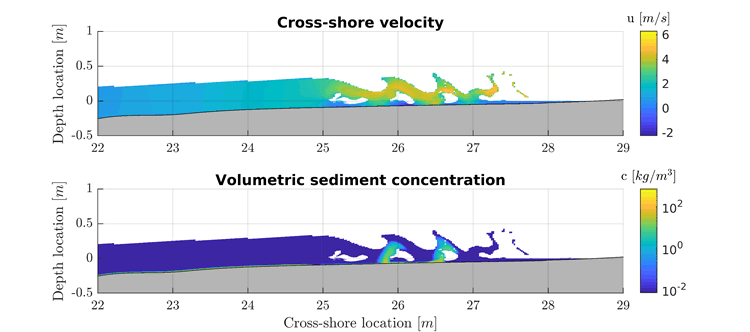J.W.M. Kranenborg1*, G.H.P. Campmans1, N.G. Jacobsen2, J.J. Van der Werf1,2, A.J.H.M. Reniers3, S.J.M.H Hulscher1
1 University of Twente,
2 Deltares,
3 Delft University of Technology,
Introduction
Numerical studies of sediment transport and morphodynamics in the swash zone generally use numerical models based on the depth-averaged shallow water equations. However, such models still have difficulty predicting the sediment transport (and subsequently morphodynamics) in the swash (see e.g. Ruffini et al., 2020). Depth-resolving models, such as models solving the Reynolds-Averaged-Navier-Stokes (RANS) equations have previously shown to accurately simulate swash hydrodynamics and also sediment transport in the surf zone (Jacobsen et al., 2014). However, applications of a RANS model capable of simulating sediment transport in the swash are limited. In this study, we present preliminary results from our RANS model on sediment transport in the swash.
Methods
The 2DV model is developed in OpenFOAM and is based on the model by Jacobsen et al., (2014). This model computes bed load and suspended load separately, where suspended load is computed using an advection-diffusion equation. We use the experiments of Young et al., (2010) to compare our model with. The experiments featured a 1:15 sloped beach made of fine sand (D50 = 0.2 mm) on which a swash event was produced by a solitary wave with a height of 60 cm.
Results and outlook
Figure 1 shows a snapshot during the uprush in one of the simulations. Our model is able to produce the large sediment fluxes and sediment plumes associated with the vortices produced by a breaking wave. Also, near the bed a layer of high sediment concentration is visible. We are currently working on the validation of these results. In the future, we aim to use the knowledge obtained from this depth-resolving model to improve sediment transport formulations for depth-averaged models.

Figure 1 Modelled cross-shore velocity (positive = onshore) and volumetric sediment concentration in a swash bore during uprush. The white gaps show the air entrained from the breaking process.
References
Jacobsen, N. G., Fredsoe, J., and Jensen, J. H. (2014). Formation and development of a breaker bar under regular waves. part 1: Model description and hydrodynamics. Coastal Engineering, 88:182 – 19
Young, Y. L., Xiao, H., and Maddux, T. (2010). Hydro- and morpho-dynamic modeling of breaking solitary waves over a fine sand beach. part i: Experimental study. Marine Geology, 269(3):107 – 118.
Ruffini, G., Briganti, R., Alsina, J. M., Brocchini, M., Dodd, N., and McCall, R. (2020). Numer-ical modeling of flow and bed evolution of bichromatic wave groups on an intermediate beach using nonhydrostatic xbeach. Journal of Waterway, Port, Coastal, and Ocean Engineering, 146(1):04019034.
I. Surname1*, F.N. Another-Surname2 , Y. Next-Surname2
1 University Name, Country; 2 Organization Name, Country
* Corresponding author: mail.name@organization.org


